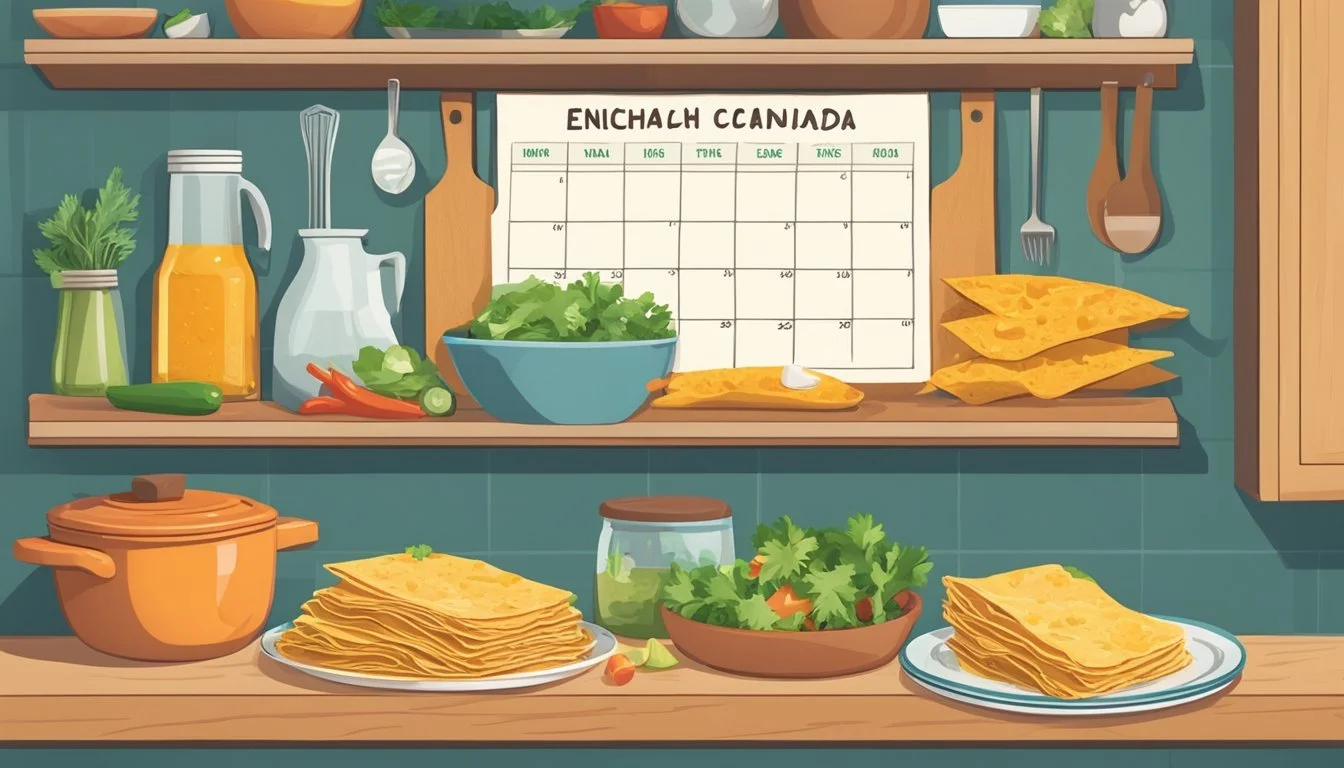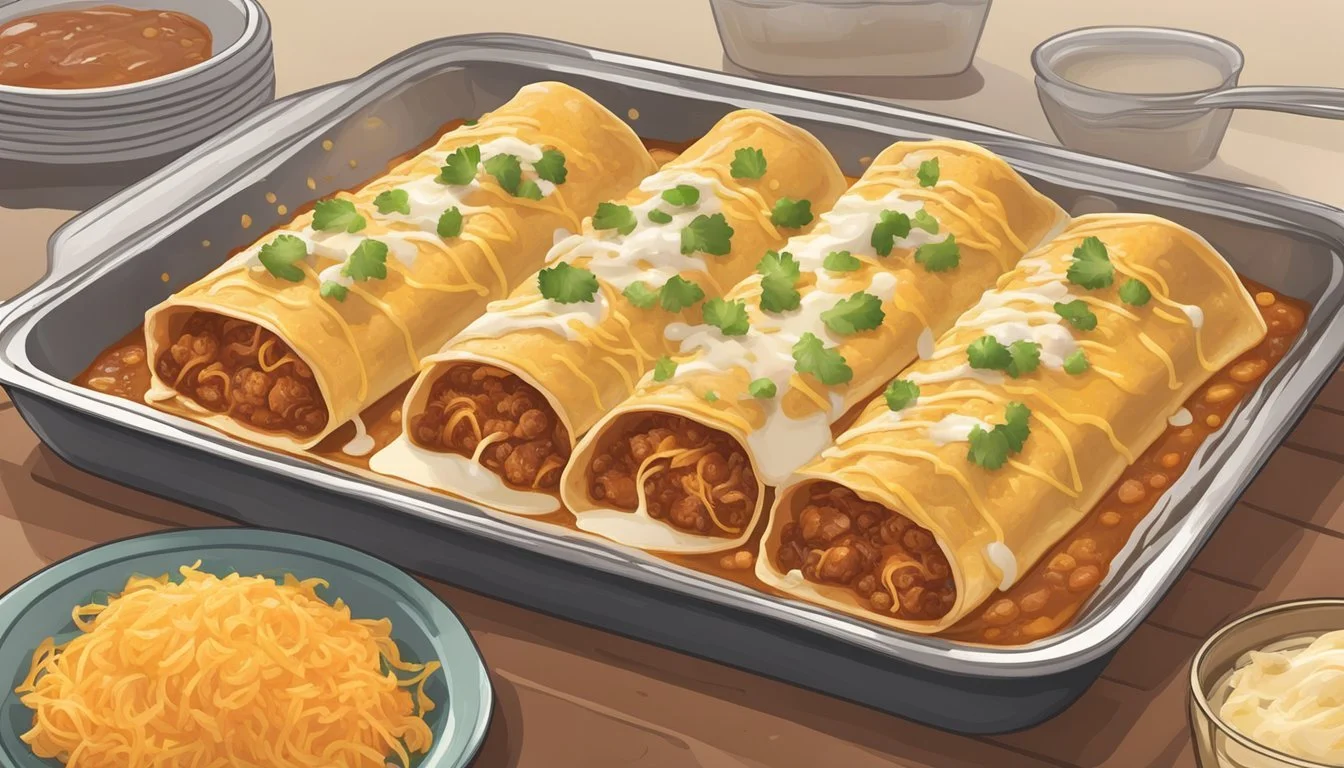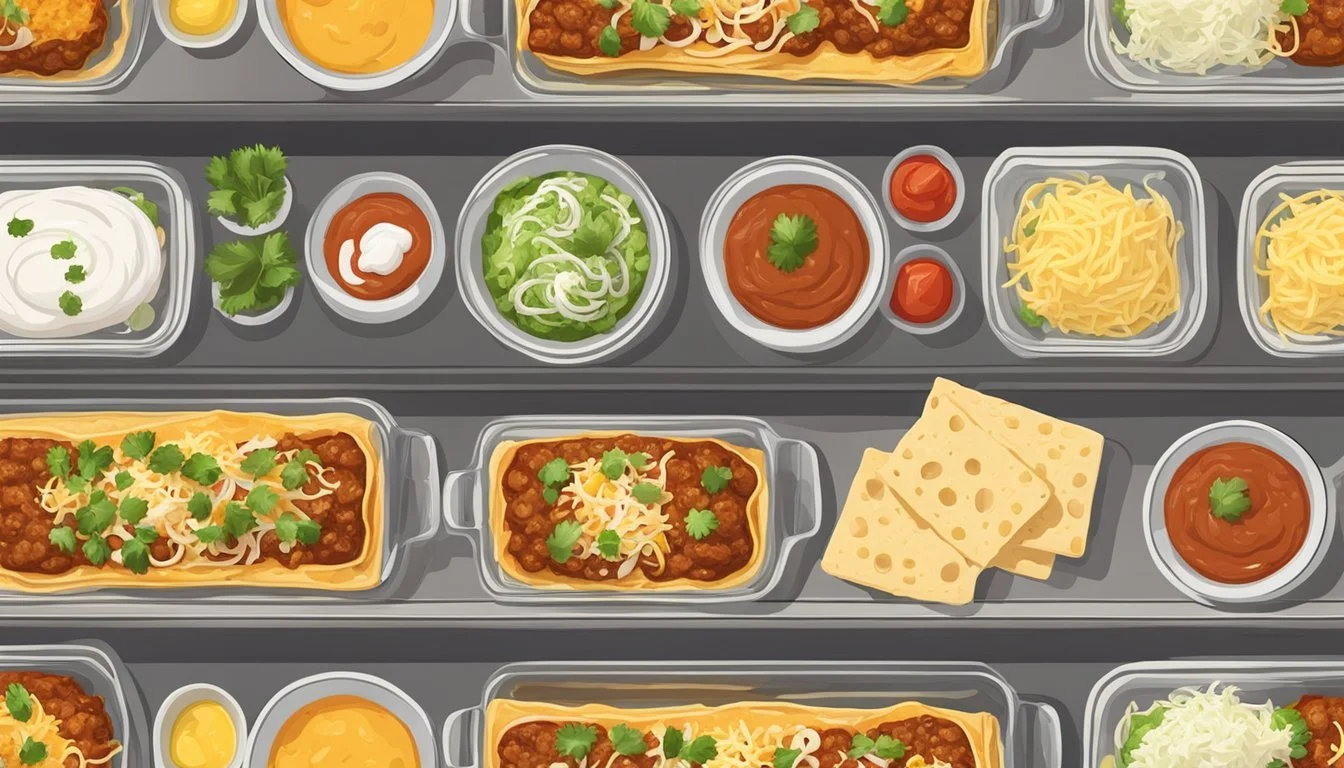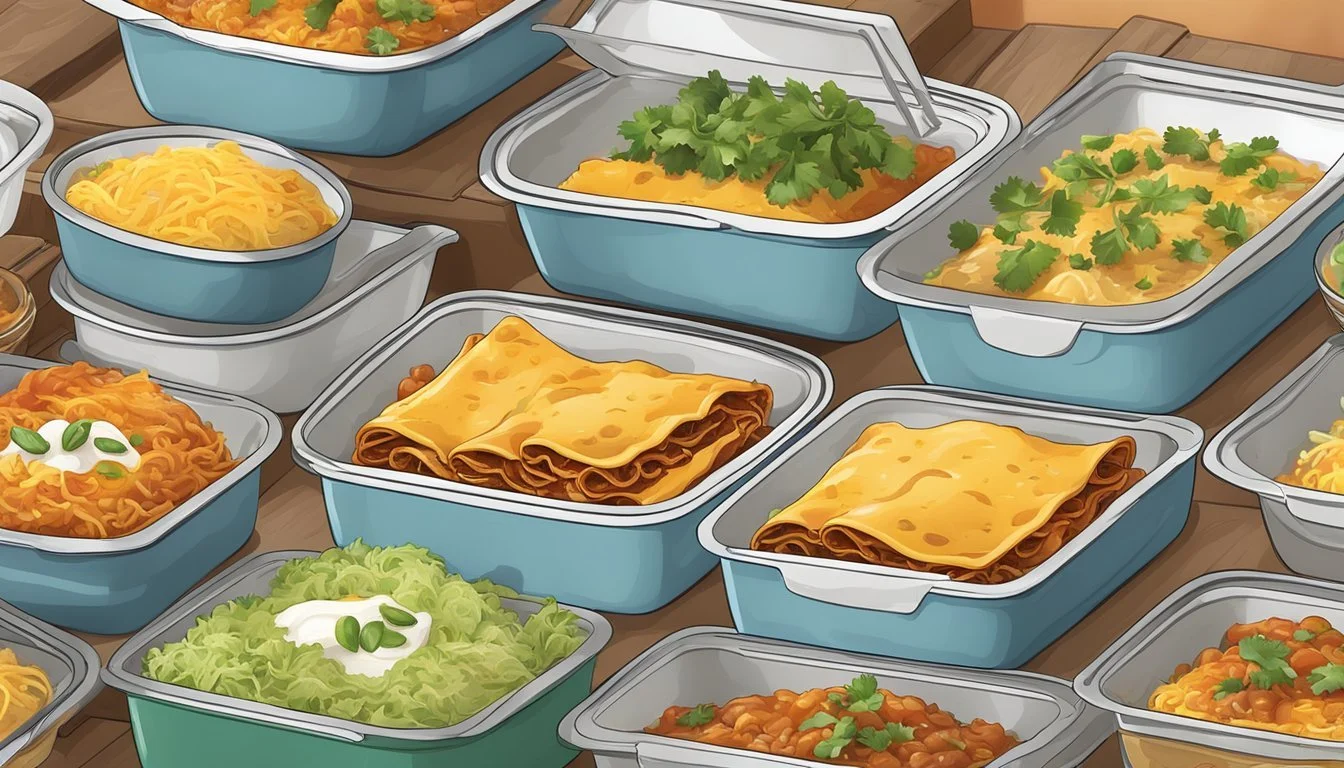How Long Do Freshly Prepared Enchiladas Last?
Shelf Life & Storage Tips
Freshly prepared enchiladas can be a delightful and flavorful meal, but their longevity is a common concern for both home cooks and culinary enthusiasts alike. The lifespan of enchiladas is contingent upon several factors including the freshness of the ingredients used, how they are stored, and the temperature at which they are kept. Proper handling and refrigeration are paramount in preserving the quality and safety of enchiladas.
After being cooked, enchiladas should be stored in the refrigerator to maintain their quality. In this cool environment, they typically remain safe for consumption for up to 3 to 5 days. Within this time frame, the enchiladas are not only safe to eat but also retain much of their initial taste and texture. It is crucial, however, to store them in an airtight container to prevent them from absorbing odors from other foods and to avoid the possibility of bacterial growth.
The freshness of enchiladas can noticeably decline if they are not stored properly. Freezing enchiladas can extend their shelf life considerably, but this will also affect their texture upon reheating. While freezing is an efficient way to keep enchiladas for prolonged periods of up to 2 to 3 months, it is important to remember that the sooner enchiladas are consumed, the more they retain their original flavor and quality.
Understanding Enchiladas
Enchiladas are a traditional Mexican dish that has gained international popularity. They consist typically of corn tortillas rolled around a filling which may include meats like chicken or beef, and are often covered with a savory enchilada sauce. Some variants use flour tortillas instead, although this is less traditional. The type of tortilla and filling used can affect both the flavor and longevity of the dish when stored.
When preparing enchiladas, chefs fill and roll the tortillas before lining them up in a baking dish. They then slather the top with sauce and sprinkle generously with cheese, ensuring a sumptuous layer of melted goodness after baking. The ensemble is cooked in an oven, usually at temperatures ranging around 350°F (177°C), until the cheese is bubbling and the edges of the tortillas start to crisp.
Chicken enchiladas (What wine goes well with chicken enchiladas?) often contain a mixture of cooked chicken, spices, and sometimes beans or vegetables inside the tortillas. In the case of beef enchiladas (What wine goes well with beef enchiladas?), ground or shredded beef takes the center stage. Both varieties are heartily embraced for their flavor and the ease with which they can be made ahead of time.
Enchiladas embody a dish that can be prepared in advance and is suitable for quick reheating, which makes them a convenient and versatile meal option. However, their ingredients and preparation method play a crucial role in determining their shelf life once made. As such, proper storage in the fridge or freezer is essential to ensure enchiladas remain safe to eat and retain their quality.
Safe Food Handling Practices
Ensuring the safety and longevity of freshly prepared enchiladas starts with proper food handling techniques from the initial selection of ingredients to the final storage. This includes choosing quality ingredients, adhering to cooking protocols to achieve the correct internal temperature, and cooling and storing the dish safely to reduce the risk of foodborne illnesses.
Ingredient Selection
Protein: Select fresh chicken or beef that has been properly refrigerated and exhibits no signs of spoilage. Cooking spoiled meat can result in food poisoning, regardless of the cooking temperature achieved.
Cheese: Choose pasteurized cheese and check for any mold or off-odors before use, as this can indicate spoilage.
Cooking Technique
Temperature: Cook enchiladas until they reach an internal temperature of at least 165°F to ensure that harmful bacteria are destroyed. Cooking oil used in preparation should not be overheated to avoid the release of harmful compounds.
Meat: Whether using chicken or beef, it’s essential to cook it thoroughly. For ground beef, a brown color throughout indicates it is cooked, while chicken juices should run clear.
Cooling and Storing
Refrigerator: Store enchiladas in the refrigerator within 2 hours of cooking to prevent bacterial growth. The refrigerator should be set below 40°F.
Covering: Wrap the enchiladas with plastic wrap or aluminum foil to protect them from airborne contaminants and moisture loss.
Shelf Life: Enchiladas should be consumed within 5 days when stored correctly in the fridge, maintaining safety and quality.
Proper Storage Conditions
Preserving the freshness and taste of freshly prepared enchiladas hinges on two key storage methods: refrigeration and freezing. The longevity of enchiladas is significantly affected by the environment they are stored in.
Refrigeration
Storing enchiladas in the refrigerator is essential for maintaining their quality over a short period. Freshly prepared enchiladas should be stored in an airtight container or wrapped securely with plastic wrap or aluminum foil to prevent air exposure and moisture loss. Enchiladas are ideally kept at a temperature of 40°F (4°C) or below, which helps inhibit bacterial growth. Refrigerated enchiladas typically remain safe for consumption for up to four to five days.
Freezing Instructions
For longer preservation, enchiladas should be frozen. To freeze enchiladas, one must wrap them tightly with aluminum foil or place them in an airtight container, minimising air exposure to prevent freezer burn. Properly packaged enchiladas can be frozen for one to two months. When ready to eat, they can be reheated in an oven without thawing, ensuring convenience and preservation of texture.
Shelf Life of Enchiladas
When considering the shelf life of enchiladas, it's essential to factor in storage conditions. Freshly prepared enchiladas boast a limited window of optimal freshness.
In the Refrigerator:
Enchiladas can safely last for 3-5 days when stored in the refrigerator.
For the best quality, it's advisable to consume them within this time frame.
Storage Tips:
Enchiladas should be stored in an airtight container or wrapped tightly with aluminum foil or plastic wrap.
Ensure the refrigerator's temperature is set below 40°F (4°C) to minimize the risk of bacterial growth.
In the Freezer:
To extend longevity, enchiladas can be frozen.
Properly stored, they can maintain quality for up to 2-3 months in the freezer.
Freezing Instructions:
Wrap individual servings or the entire batch snugly, preventing air exposure.
Label with the freezing date to track and manage the expiration period.
When consuming enchiladas after storage, one must check for signs of spoilage such as off odors, discoloration, or mold. These signs indicate that the enchiladas are no longer safe to eat. Observing the storage guidelines ensures that the enchiladas remain delicious and safe for consumption within the designated shelf life.
Reheating for Best Quality
For enchiladas that maintain their texture and flavor, reheating them properly is crucial. Selecting the right method plays a significant role in preserving the quality of this dish.
Oven Method
To reheat enchiladas in a conventional oven, one should:
Preheat the oven to 350°F (175°C).
Wrap the enchiladas in aluminum foil to retain moisture.
Place them in an oven-safe dish and heat for about 20-25 minutes, until the enchiladas are heated through.
This method helps in evenly warming the enchiladas, preserving their texture.
Microwave Technique
For a quick reheat, the microwave can be utilized:
Place the enchiladas on a microwave-safe plate.
Cover with a microwave-safe lid or a splatter guard.
Heat on high for about 2 minutes, then check.
If necessary, poke holes in the enchiladas or cut into smaller pieces to ensure even heating.
This method is faster but may slightly affect the texture, making it less crispy.
Toaster Oven Reheating
A toaster oven also provides an efficient way to reheat:
Set the toaster oven to 300°F (149°C).
Cover the enchiladas loosely with foil.
Heat for about 5-10 minutes, checking halfway to assess the temperature.
Using a toaster oven can help retain the crispiness and texture of the enchiladas while ensuring they are thoroughly heated.
Freezing and Thawing Enchiladas
When one wants to extend the shelf life of enchiladas, freezing is an excellent method. Ensuring proper freezing technique can prevent freezer burn, and understanding the correct thawing process is crucial to maintain the quality of the dish.
How to Freeze
To freeze enchiladas effectively, one should first assemble them in a baking dish without baking. In preventing freezer burn and ensuring the enchiladas don't stick to the container, here is a step-by-step method:
Line the baking dish: Use parchment paper or foil to line the dish, extending it up the sides for easy removal later.
Assemble enchiladas: Place the enchiladas in the lined dish.
Cover appropriately: Seal the dish with an additional layer of foil, pressing the edges to eliminate air exposure.
It's important for the enchiladas to be frozen until solid, which typically takes up to three hours. By freezing enchiladas unbaked, one preserves their freshness and prevents the tortillas from becoming soggy upon reheating.
Thawing Process
The correct thawing of enchiladas is critical for both food safety and quality. To thaw enchiladas properly, one should follow these instructions:
Refrigerator thawing: Transfer the enchiladas from the freezer to the refrigerator and allow them to thaw overnight. This is the safest method as it keeps the enchiladas at a safe temperature throughout the process.
Microwave thawing: If short on time, one can also use a microwave to thaw enchiladas. Place them in a microwave-safe dish and utilize the defrost setting.
For optimal results, one should bake the thawed enchiladas in a preheated oven until they're heated through. Baking time may require adjustment if enchiladas are not fully thawed. It's important to check the internal temperature of the enchiladas to ensure they are heated evenly and thoroughly before serving.
Meal Prepping with Enchiladas
Meal prepping enchiladas is an effective way to ensure a quick and comforting meal during a hectic week. Making enchiladas ahead of time involves preparing the fillings, assembling the enchiladas, and then either storing them in the refrigerator or freezing them before the final baking step. This strategy allows one to maximize time and resources while minimizing mealtime stress.
Ingredients play a crucial role in meal prep. Freshness and quality determine the longevity of the prepared enchiladas. Utilizing a variety of proteins or vegetarian options, such as beans or vegetables, adds diversity. Storing the enchiladas properly in an airtight container extends their freshness, typically 3-5 days in the refrigerator or up to 3 months in the freezer.
When assembling enchiladas for future use, using the right baking dish or casserole is key. It should be suitable for both freezing and baking. Here's a condensed guide to prepping and storing:
Assembly:
Choose the desired filling and tortillas.
Roll the filled tortillas and place them seam-side down in the dish.
Storing:
Refrigeration: Cover the dish with foil or plastic wrap.
Freezing: Wrap the dish tightly with foil, label, and date.
Baking:
From Refrigerated: Bake at 375°F for 25-30 minutes.
From Frozen: Extend baking time, typically an additional 10-20 minutes.
Remember to drizzle extra sauce and sprinkle cheese on top before baking to ensure that the enchiladas are moist and flavorful. The end result should be a satisfying, homemade meal that’s ready when needed.
FAQs on Enchiladas Storage
When it comes to storing enchiladas, understanding proper refrigeration and freezer techniques is essential for maintaining freshness and preventing food poisoning. These FAQs provide guidance on keeping your enchilada leftovers safe and delicious.
Are Enchiladas Freezer-Friendly?
Yes, enchiladas are freezer-friendly. To freeze, one should let the casserole cool to room temperature, then wrap it tightly in foil and place it in an airtight container or a freezer bag. Label it with the expiration date and it can last for up to 3 months. For optimal flavor upon reheating, this timeframe should be adhered to.
How to Detect Spoilage?
To detect spoilage, check for any color change, an off smell, or mold growth. Any of these signs indicate that the enchiladas are no longer safe to eat and should be discarded immediately. Leftovers should always be inspected before consumption to prevent any risk of food poisoning.
Can You Refrigerate Unbaked Enchiladas?
Unbaked enchiladas can be refrigerated; however, they should be assembled in a dish, covered with foil, and placed in the fridge. They are best when cooked within 24-48 hours of refrigeration to ensure the fillings do not become soggy and the flavor remains intact. It's important to note the date of refrigeration to track freshness.
Ensuring Nutritional Integrity
When storing freshly prepared enchiladas, maintaining the nutritional integrity of the ingredients is essential. Ingredients should be fresh and high-quality to begin with, as this will affect both the flavor and the nutritional value over time. Cheese, a common topping for enchiladas, contains calcium and protein but can also be high in saturated fat. Opting for low-fat varieties or using less cheese can help maintain nutritional balance.
For protein sources like chicken and beef, it's crucial to store the enchiladas in the refrigerator within two hours of cooking to prevent bacterial growth. Chicken is a lean protein and provides essential amino acids, while beef offers iron and B vitamins. However, beef tends to be higher in fat, so lean cuts are preferable for a healthier dish.
Vegetables added to enchiladas are rich in vitamins, minerals, and fiber. To ensure they retain their nutritional value, the enchiladas should be wrapped tightly and stored correctly. Vegetables are sensitive to heat and light, and their nutrient quality can deteriorate if improperly stored.
Storage Tips:
Refrigeration: Store enchiladas at or below 40°F.
Airtight Containers: Use sealed containers to prevent air exposure.
Prompt Storage: Refrigerate enchiladas within two hours of preparation.
Here is a table summarizing the key nutritional facts of common enchilada ingredients:
Ingredient Nutritional Benefit Storage Recommendation Cheese Calcium, Protein Use low-fat, store cold Chicken Lean Protein, Amino Acids Refrigerate quickly Beef Iron, B Vitamins, Protein Choose lean cuts Vegetables Vitamins, Minerals, Fiber Airtight, cool storage
By following these guidelines, one can not only extend the shelf-life of enchiladas but also preserve their nutritional value, making sure they remain a wholesome choice upon reheating and consumption.
Customizing Enchiladas for Dietary Needs
Enchiladas are a versatile dish that can be tailored to meet a variety of dietary requirements. By substituting key ingredients, one can create enchiladas suitable for vegetarian, vegan, gluten-free, or low-carb diets, ensuring everyone can enjoy this flavorful meal.
Vegetarian and Vegan Variations
For vegetarian enchiladas, one can replace meat with an assortment of beans, such as black or pinto beans, and vegetables like bell peppers, onions, and mushrooms. Cheese is still used; however, for vegan enchiladas, it's important to use dairy-free cheese alternatives. Meat substitutes such as textured vegetable protein (TVP) or lentils can also be used to mimic the texture and protein content of traditional fillings.
Vegan Enchilada Ingredients:
Beans: black, pinto
Vegetables: bell peppers, onions, mushrooms
Vegan cheese
Meat substitutes: TVP, lentils
Gluten-Free Adaptations
Gluten-free enchiladas primarily require the use of corn tortillas, which are naturally free of gluten, unlike flour tortillas. Fillings and sauces need to be verified as gluten-free. This includes checking that any chicken or beef used is not marinated or treated with ingredients containing gluten. Store-bought sauces should be labeled gluten-free, or one can make a sauce from scratch to ensure compliance.
Gluten-Free Components:
Tortillas: 100% corn tortillas
Sauces: Verified or homemade gluten-free sauces
Fillings: Unmarinated chicken, beef, or vegetable-based
Low-Carb and Keto-Friendly Options
To make low-carb or keto-friendly enchiladas, traditional tortillas are replaced with low-carb alternatives, such as those made from almond flour or coconut flour. Fillings remain largely protein-based, featuring chicken, beef, or cheese, but with less emphasis on beans, which are higher in carbohydrates. Vegetables are included, focusing on low-carb options like spinach, zucchini, and peppers.
Keto-Friendly Enchilada Elements:
Tortillas: Almond or coconut flour tortillas
Fillings: Chicken, beef, spinach, zucchini, peppers
Cheese: Regular cheese, high in fat and low in carbs
By carefully selecting ingredients, enchiladas can be customized to fit within these dietary frameworks while still delivering the taste and experience of the traditional dish.
Tips for Enhancing Enchiladas
When striving for the best enchilada experience, one should consider both the ingredients and the sauces used. These factors play pivotal roles in the flavor profile and overall quality of the dish.
Ingredient Substitutions
Enchiladas offer flexibility in their fillings, making it simple to substitute ingredients to suit dietary preferences or to escalate the flavor. For a chicken enchilada recipe, one might switch traditional chicken for marinated tofu or seasoned beans for a vegetarian twist. To elevate homemade enchiladas, use a blend of premium cheeses, adding a cheesy richness with options like sharp cheddar or smoked gouda. Fresh, locally-sourced vegetables can also bolster the taste and nutrition of the filling.
Sauce Selections
The sauce is the heart of enchilada's flavor. For a genuinely standout homemade sauce, consider blending fire-roasted tomatoes with a mix of chili peppers to create a complex, smoky salsa. A basic enchilada sauce can be brought to life with the addition of fresh herbs and a hint of dark chocolate for depth. Those aiming for an exquisite touch can integrate roasted garlic or a splash of citrus to brighten the overall profile. Pairing the right sauce with the filling is essential; a spicy sauce can complement simple fillings, while a richer, more mellow sauce might better suit a filling that's robust on its own.













